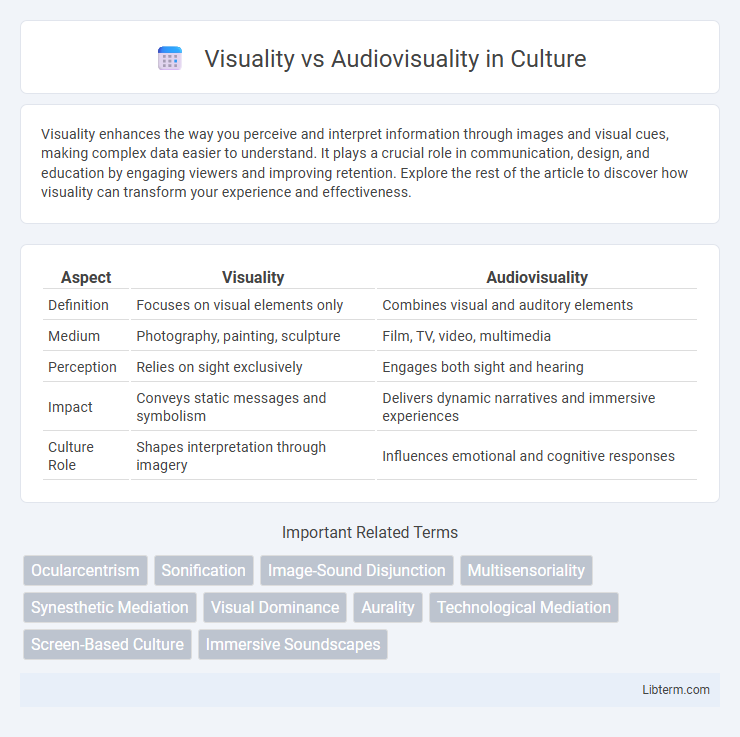Visuality enhances the way you perceive and interpret information through images and visual cues, making complex data easier to understand. It plays a crucial role in communication, design, and education by engaging viewers and improving retention. Explore the rest of the article to discover how visuality can transform your experience and effectiveness.
Table of Comparison
| Aspect | Visuality | Audiovisuality |
|---|---|---|
| Definition | Focuses on visual elements only | Combines visual and auditory elements |
| Medium | Photography, painting, sculpture | Film, TV, video, multimedia |
| Perception | Relies on sight exclusively | Engages both sight and hearing |
| Impact | Conveys static messages and symbolism | Delivers dynamic narratives and immersive experiences |
| Culture Role | Shapes interpretation through imagery | Influences emotional and cognitive responses |
Understanding Visuality: Definition and Scope
Visuality refers to the ways in which visual perception and representation shape knowledge, culture, and experience, emphasizing how images and sight influence understanding. It encompasses the study of visual phenomena, semiotics, and the cultural contexts that inform how visuals are interpreted and valued. Understanding visuality involves examining the power dynamics, historical frameworks, and sensory engagement that govern visual communication beyond merely viewing images.
Exploring Audiovisuality: Merging Senses
Audiovisuality merges visual and auditory senses to create immersive multimedia experiences that enhance perception and emotional impact. By integrating images, sounds, and sometimes text, it enriches communication and storytelling beyond the limitations of purely visual content. Technologies like AR, VR, and cinema exploit audiovisuality to engage multiple sensory pathways, deepening user interaction and cognitive retention.
Historical Evolution of Visual and Audiovisual Media
The historical evolution of visual and audiovisual media traces back to early cave paintings and shadow puppetry, evolving through photography and silent films to contemporary digital cinema and virtual reality. Visual media initially relied on static images and still photography, while audiovisual media integrated sound with moving images, revolutionizing storytelling and audience engagement. The transition from analog to digital technologies has further transformed these media forms, enabling interactive and immersive experiences across platforms.
Cognitive Impacts: Seeing vs. Seeing and Hearing
Visuality emphasizes the primacy of visual perception, enhancing pattern recognition and spatial reasoning by engaging the brain's occipital lobe. Audiovisuality combines visual stimuli with auditory input, activating multimodal integration areas such as the superior temporal sulcus, which improves memory retention and comprehension through synchronized sensory processing. Cognitive impacts show that audiovisual experiences facilitate deeper information encoding and emotional engagement compared to visual-only stimuli.
Visual-Only Communication: Strengths and Limitations
Visual-only communication excels in conveying complex spatial information and emotional nuances through imagery, graphs, and symbols, making it highly effective for quick comprehension and universal understanding. However, its limitations include the inability to convey sound-based information, such as tone or auditory cues, which can result in misinterpretation or reduced context. Reliance solely on visuals may also hinder accessibility for individuals with visual impairments, necessitating complementary modalities for inclusive communication.
The Power of Audiovisual Integration
Audiovisual integration enhances cognitive processing by simultaneously engaging both visual and auditory channels, leading to improved memory retention and comprehension. This multimodal approach leverages the brain's natural ability to synthesize sensory information, creating more immersive and impactful communication experiences. Studies show that audiovisual stimuli boost emotional resonance and attention, making messages more persuasive and memorable compared to purely visual presentations.
Case Studies: Film, Television, and Digital Platforms
Visuality in film emphasizes static composition and cinematography to convey meaning through imagery, while audiovisuality integrates sound design and dialogue to enhance narrative immersion in television. Case studies reveal how digital platforms leverage interactivity and multimodal storytelling, blending visual and auditory elements for personalized viewer experiences. The success of series like "Stranger Things" on Netflix illustrates the power of audiovisual synergy in driving engagement through nostalgic visuals coupled with an atmospheric soundtrack.
Audience Engagement: Visuality versus Audiovisuality
Visuality engages audiences primarily through images, design, and spatial composition, allowing for immediate interpretation and emotional connection. Audiovisuality combines sight and sound, enhancing engagement by stimulating multiple sensory channels, which can deepen understanding and retention. Studies show that audiovisual content increases viewer attention and emotional resonance compared to purely visual media.
Technological Advances Shaping Perception
Technological advances in virtual reality and augmented reality have significantly enhanced audiovisuality by merging visual and auditory stimuli, creating immersive experiences that deepen sensory perception. High-resolution displays combined with spatial audio systems enable users to perceive environments with unprecedented realism, reshaping cognitive processing of sensory information. These innovations shift emphasis from static visuality to dynamic audiovisual integration, influencing fields such as entertainment, education, and communication.
Future Trends: The Convergence of Visual and Audiovisual Experiences
Future trends in media emphasize the convergence of visual and audiovisual experiences, driven by advancements in augmented reality (AR), virtual reality (VR), and immersive technologies. Innovations in these fields enable seamless integration of sensory inputs, creating more engaging, multisensory storytelling that enhances user interaction and emotional impact. This convergence is shaping new platforms and formats, transforming entertainment, education, and marketing into hybrid experiences that blend sight and sound dynamically.
Visuality Infographic

 libterm.com
libterm.com